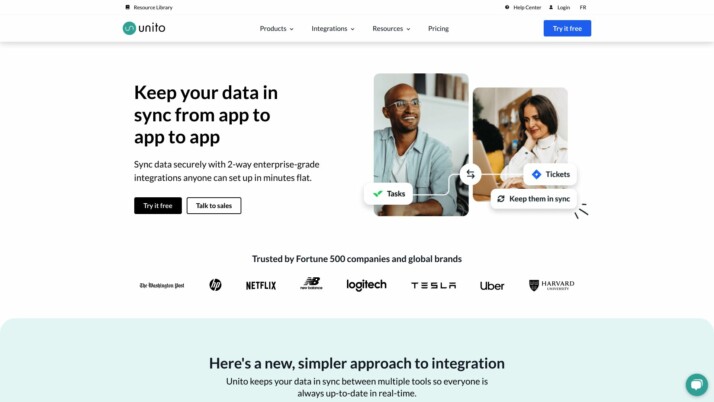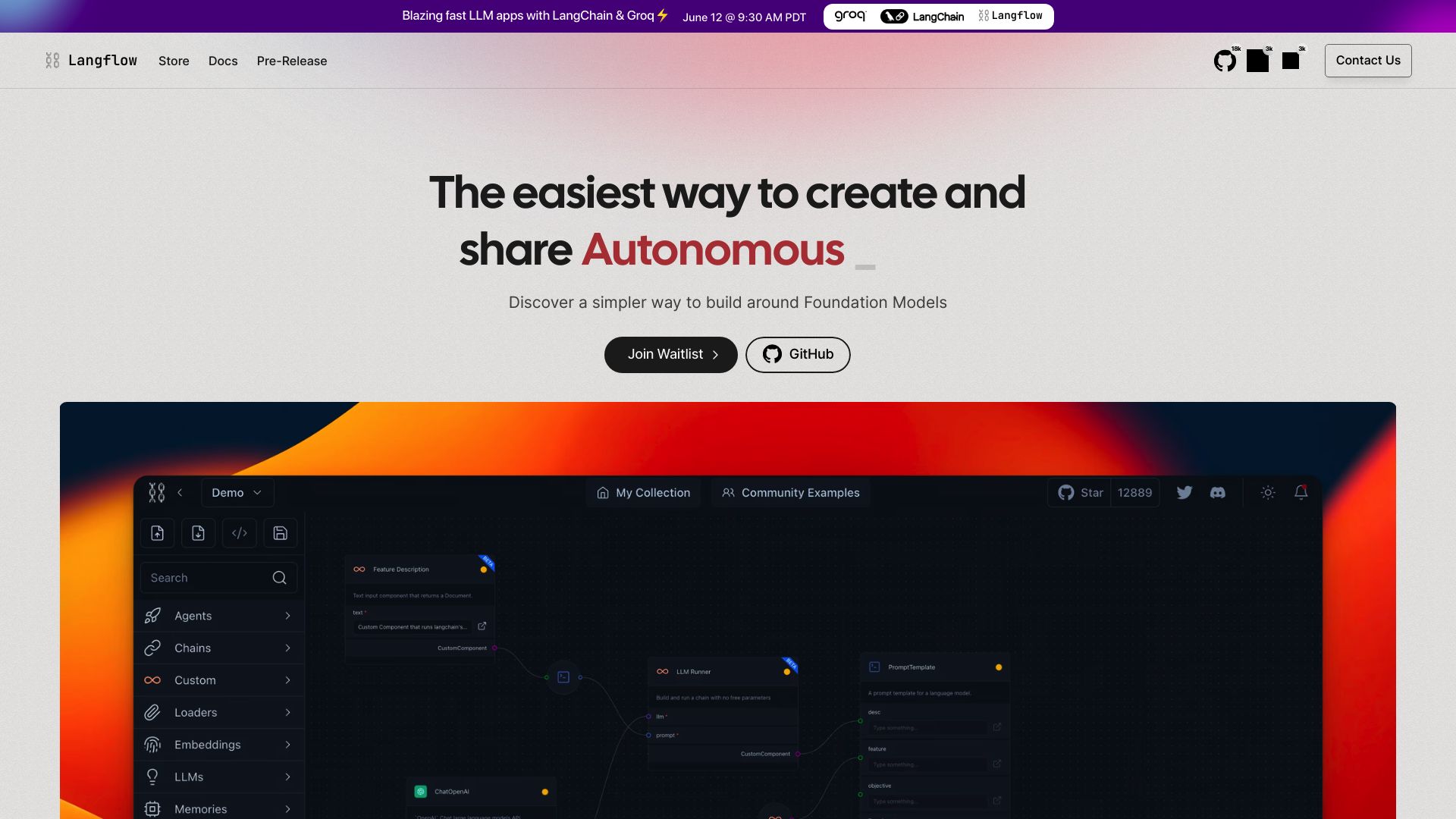Unito vs. Langflow: Comparing Workflow and AI Development Tools
AI technology revolutionizes business operations, but choosing the right platform can be daunting. This comparison explores Unito vs. Langflow, and SmythOS, three powerful tools reshaping workflow automation and AI development. Unito excels in cross-platform integration, Langflow simplifies AI application creation, while SmythOS combines these strengths with advanced features. We’ll examine each platform’s unique capabilities, discussing how they streamline processes, enhance collaboration, and empower users to harness AI’s potential. Whether you’re a developer seeking robust APIs, a business leader prioritizing scalability, or an entrepreneur looking for user-friendly solutions, this guide will help you navigate the AI landscape and select the ideal platform for your needs.
Unito Overview
Unito streamlines cross-platform collaboration through its powerful workflow automation and data synchronization platform. The software seamlessly connects popular tools like Asana, Jira, Trello, and GitHub, enabling teams to work efficiently across diverse applications.
Unito’s visual workflow designer empowers users to create custom integrations without coding. The platform’s real-time two-way sync keeps information updated across connected tools, while deep field mapping allows precise control over data flow. This flexibility makes Unito ideal for complex project management, task tracking, and team collaboration scenarios.


Unito’s visual workflow designer empowers users to create custom integrations without coding. The platform’s real-time two-way sync keeps information updated across connected tools…
Security and scalability stand out as key strengths. Unito offers enterprise-grade features including SOC 2 Type II certification, OAuth authentication, and HTTPS encryption. The platform can handle syncing thousands of tasks, making it suitable for organizations of all sizes.
While Unito excels at tool integration, it lacks some advanced AI capabilities found in other platforms. The focus is on workflow automation rather than autonomous agents or natural language processing. However, Unito’s robust API support allows for potential AI enhancements through third-party integrations.
Unito’s user-friendly interface and extensive tool connectors make it accessible for both technical and non-technical users. The platform’s activity logs, test mode, and customizable rules provide transparency and control over automated workflows. For businesses aiming to break down tool silos and improve cross-team collaboration, Unito offers a compelling solution that adapts to existing processes while driving efficiency gains.
Langflow Overview
Langflow revolutionizes AI application development with its open-source, low-code platform. Designed for simplicity and power, Langflow enables users to create AI-driven solutions ranging from basic tasks to complex workflows. The platform’s intuitive drag-and-drop interface allows developers and non-technical users alike to construct sophisticated AI applications visually, leveraging pre-built LangChain components such as Large Language Models and agents.
Langflow revolutionizes AI application development with its open-source, low-code platform… enables users to create AI-driven solutions ranging from basic tasks to complex workflows.
At its core, Langflow prioritizes accessibility without sacrificing functionality. The platform offers straightforward installation options, including pip and pipx, with the added convenience of running directly within HuggingFace Spaces. This flexibility eliminates local setup hurdles, making AI development more approachable for a wider audience.
Langflow’s robust feature set includes a powerful Command-Line Interface (CLI) for advanced users, enabling fine-tuned control over project settings. The platform also emphasizes security, incorporating enhanced login mechanisms and customizable authentication options. These features prove particularly valuable for public deployments, ensuring data protection and user management.
Langflow extends its capabilities through API integration, allowing programmatic access to components and workflows. The platform supports asynchronous processing for efficient resource management and enables users to export and import flows as JSON files. This interoperability enhances Langflow’s versatility, allowing created workflows to function as Python objects or standalone APIs.


While Langflow offers significant advantages, users should consider potential limitations. The platform’s low-code approach, while accessible, may present a learning curve for those entirely new to AI workflows. Additionally, highly specific or complex requirements might be better served by high-code solutions offering more granular control. Scalability concerns may arise for large-scale deployments or intricate workflows, requiring careful consideration during implementation.
Feature Comparison
Unito and Langflow offer distinct approaches to workflow automation and AI development. Unito excels in cross-platform integration, providing real-time two-way synchronization between popular tools like Asana, Jira, and Trello. Its visual workflow designer enables users to create custom integrations without coding, making it accessible for both technical and non-technical users. Unito’s strength lies in its deep field mapping and customizable rules, allowing precise control over data flow between different applications.
Langflow, on the other hand, focuses on AI application development with its open-source, low-code platform. It leverages pre-built LangChain components, including Large Language Models and agents, to construct AI-driven solutions. Langflow’s drag-and-drop interface simplifies the creation of complex AI workflows, making it ideal for developers and researchers looking to prototype and experiment with AI applications quickly.
In terms of security, Unito offers enterprise-grade features such as SOC 2 Type II certification and HTTPS encryption, while Langflow emphasizes enhanced login mechanisms and customizable authentication options. However, Langflow’s open-source nature may require additional security considerations for enterprise deployments. Both platforms lack some advanced AI capabilities found in more specialized tools, but Langflow’s focus on AI development gives it an edge in creating intelligent agents and leveraging machine learning models.
Feature Comparison Table
| Unito | Langflow | SmythOS | |
|---|---|---|---|
| CORE FEATURES | |||
| Autonomous Agents | ❌ | ✅ | ✅ |
| Multimodal | ❌ | ✅ | ✅ |
| Problem-Solving Capabilities | ✅ | ❌ | ✅ |
| Human-AI Interaction | ❌ | ✅ | ✅ |
| Work as Team | ✅ | ❌ | ✅ |
| Bulk Work | ✅ | ❌ | ✅ |
| Agent Work Scheduler | ❌ | ❌ | ✅ |
| SECURITY | |||
| Data Encryption | ✅ | ❌ | ✅ |
| IP Control | ❌ | ❌ | ✅ |
| COMPONENTS | |||
| Foundation AIs | ❌ | ❌ | ✅ |
| Huggingface AIs | ❌ | ✅ | ✅ |
| All other APIs, RPA | ✅ | ❌ | ✅ |
| Classifiers | ❌ | ✅ | ✅ |
| Logic | ✅ | ✅ | |
| Data Lakes | ❌ | ✅ | ✅ |
| DEPLOYMENT OPTIONS (EMBODIMENTS) | |||
| Deploy as API | ✅ | ❌ | ✅ |
| Deploy as Webhook | ❌ | ✅ | ✅ |
| Staging Domains | ❌ | ✅ | ✅ |
| Production Domains | ✅ | ❌ | ✅ |
| API Authentication (OAuth + Key) | ✅ | ❌ | ✅ |
| Deploy as Site Chat | ❌ | ❌ | ✅ |
| Deploy as Scheduled Agent | ❌ | ✅ | ✅ |
| Deploy as GPT | ❌ | ❌ | ✅ |
| DATA LAKE SUPPORT | |||
| Hosted Vector Database | ❌ | ✅ | ✅ |
| Sitemap Crawler | ❌ | ❌ | ✅ |
| YouTube Transcript Crawler | ❌ | ❌ | ✅ |
| URL Crawler | ❌ | ❌ | ✅ |
| PDF Support | ❌ | ❌ | ✅ |
| Word File Support | ❌ | ✅ | ✅ |
| TXT File Support | ❌ | ✅ | ✅ |
Best Alternative to Unito and Langflow
SmythOS stands out as the superior alternative to Unito and Langflow for AI agent development and deployment. Our platform combines the best of both worlds, offering seamless integration capabilities like Unito and powerful AI development tools like Langflow, while surpassing both in overall functionality and ease of use.
We’ve designed SmythOS to address the limitations of other platforms. Unlike Unito’s focus on workflow integration or Langflow’s emphasis on AI prototyping, SmythOS provides a comprehensive solution for creating, deploying, and managing AI agents across various use cases. Our drag-and-drop interface simplifies the development process, making it accessible to users of all skill levels while still offering advanced customization options for experienced developers.
SmythOS excels in its feature set, offering capabilities that neither Unito nor Langflow can match. We provide support for autonomous agents, multimodal interactions, and advanced problem-solving capabilities.
SmythOS excels in its feature set, offering capabilities that neither Unito nor Langflow can match. We provide support for autonomous agents, multimodal interactions, and advanced problem-solving capabilities. Our platform enables multi-agent collaboration and human-AI interaction, features that are critical for complex AI applications but limited or absent in Unito and Langflow.
Security and scalability set SmythOS apart from the competition. We offer robust data encryption, IP control, and OAuth authentication, ensuring your AI agents and data remain secure. Our platform scales effortlessly to meet enterprise-level demands, a crucial factor that Langflow’s open-source nature may struggle to address. Additionally, SmythOS supports a wide range of deployment options, including APIs, webhooks, scheduled agents, and even GPT integrations, providing flexibility that surpasses both Unito and Langflow.
By choosing SmythOS, you’re not just selecting an AI agent builder; you’re investing in a future-proof platform that continually evolves to meet the changing landscape of AI technology. Our commitment to innovation ensures that you’ll always have access to cutting-edge features and capabilities, empowering you to stay ahead in the fast-paced world of AI development and automation.
Conclusion
Unito and Langflow offer unique approaches to workflow automation and AI development, each with distinct strengths. Unito excels in cross-platform integration, providing seamless synchronization between popular tools. Its visual workflow designer and deep field mapping capabilities make it a powerful choice for businesses seeking to streamline collaboration across diverse applications. Langflow, on the other hand, focuses on AI application development with its open-source, low-code platform, making it an attractive option for those looking to prototype AI solutions quickly.
However, SmythOS emerges as the superior choice, combining the best of both worlds and offering additional advanced features. Our platform provides a comprehensive solution for creating, deploying, and managing AI agents with unparalleled ease and flexibility. SmythOS’s intuitive drag-and-drop interface, extensive integration ecosystem, and support for multiple AI models make it accessible to users of all technical backgrounds while still offering the power and customization needed for complex AI workflows.
What truly sets SmythOS apart is its versatility in deployment options and its focus on multi-agent orchestration. We enable you to create AI agents once and deploy them across various platforms, from chatbots to APIs, and even as ChatGPT plugins or Alexa skills. This ’Create Once, Deploy Anywhere’ approach, combined with our support for collaborative AI agents, positions SmythOS as the ideal platform for businesses looking to leverage AI technology at scale.
If you’re ready to revolutionize your workflow and harness the full potential of AI, we invite you to explore our diverse range of AI-powered agent templates. These templates cover multiple business categories and offer a quick start to enhancing your operations with AI. To experience the power of SmythOS firsthand, create a free SmythOS account and start building AI agents with no time limit. Join us in shaping the future of AI-powered productivity and innovation.
Last updated:
Disclaimer: The information presented in this article is for general informational purposes only and is provided as is. While we strive to keep the content up-to-date and accurate, we make no representations or warranties of any kind, express or implied, about the completeness, accuracy, reliability, suitability, or availability of the information contained in this article.
Any reliance you place on such information is strictly at your own risk. We reserve the right to make additions, deletions, or modifications to the contents of this article at any time without prior notice.
In no event will we be liable for any loss or damage including without limitation, indirect or consequential loss or damage, or any loss or damage whatsoever arising from loss of data, profits, or any other loss not specified herein arising out of, or in connection with, the use of this article.
Despite our best efforts, this article may contain oversights, errors, or omissions. If you notice any inaccuracies or have concerns about the content, please report them through our content feedback form. Your input helps us maintain the quality and reliability of our information.
